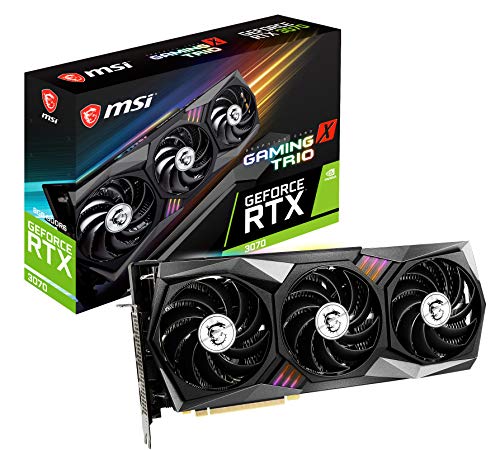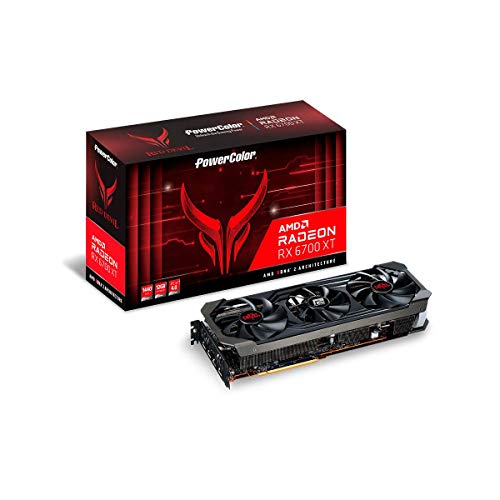RTX 3070 vs RX 6700 XT: Which GPU Should You Buy?
- The NVIDIA RTX 3070 outperforms AMD's RX 6700 XT in most games across all resolutions, but has less VRAM, affecting its performance in VRAM-intensive scenarios.
- RTX 3070 excels in productivity tasks and has a more robust software offering with features beneficial for content creators and gamers.
- Choose RTX 3070 for better overall performance and features, or RX 6700 XT if you need more VRAM and potentially lower cost.
The NVIDIA RTX 3070 and AMD’s RX 6700 XT have gained popularity among budget-conscious users. From the moment they were released, they brought about intense competition in the mid-ranged market, each presenting its own set of advantages and disadvantages.
Let’s go over into their performance metrics and overall value to assist you in making an informed decision.
Table of Contents
Specifications Overview
Starting with NVIDIA, the RTX 3070 is based on the GA104-300 GPU (5888 CUDA Cores) designed using the Ampere architecture. It hosts a nominal 8GB of GDDR6 memory over a 256-bit interface, netting us 448GB/s of effective bandwidth.
| CATEGORY | RX 6700 XT | RTX 3070 |
|---|---|---|
| GPU | Navi22 | AD103-400 |
| Memory | 12 GB | 8 GB |
| Bus Interface | 192-Bit | 256-Bit |
| Bandwidth | 384 GB/s | 448 GB/s |
| Memory Type | GDDR6 | GDDR6 |
| Launch MSRP | $479 | $499 |
| TDP | 230W | 220W |
AMD’s Radeon RX 6700 XT uses the Navi22 GPU with 2560 FP32 units built using RDNA2, Team Red’s creme de la creme architecture. The 6700 XT’s 12GB VRAM nets you a huge 50% lead over the RTX 3070. Both GPUs have identical TDPs and results show identical power consumption levels.
Noise and temperatures will vary depending on the specific model you purchase. Generally, RDNA2 and Ampere tend to have similar efficiency levels, so don’t expect to see any significant differences like those found with RDNA3 and Ada Lovelace.
READ MORE: HDMI 2.1 vs DisplayPort 1.4: Which is Better in 2024? ➜
Gaming Benchmarks
We’ve referenced numerous sources for our gaming comparisons, with Hardware Unboxed being a primary choice given its widespread credibility in GPU reviews. While alternative sources are available, we’ve opted for a selection that offers diverse and dependable comparisons.
The test bench features AMD’s Zen3 kingpin, the Ryzen 9 5950X, coupled with 32GB of DDR4-3200 CL14 dual-channel and dual-rank memory. This review dates back to the 18th of March, 2022, so there is a small driver-induced X factor at play here, though we assume the difference to be minimal. For reference, HUB’s test setup used Adrenalin 22.2.3 and GeForce Game Ready 511.79 drivers for either GPU.
↪ RTX 3070 Leads at 1080p, 1440p, and 4K Resolutions
Let’s cut to the chase, we’re obviously not going to be comparing all 50 games, instead, we’ll go over the summary. As per HUB, at 1080p, only Doom Eternal and Assassin’s Creed Valhalla saw the RX 6700 XT beating the RTX 3070 by more than 5%. Moreover, the RTX 3070 on the other hand was faster by 5% or more in 34 of the 50 games tested.
You’d expect AMD to clap back at 1440p, given its 12GB Frame Buffer, however, that’s simply not the case. At 1440p, the RTX 3070 was on average, 13% faster than the Radeon RX 6700 XT across 50 games. At 4K, this difference climbs up to 19% on average, with the RTX 3070 in lead.
NVIDIA is quite ahead in the number game, yet, there’s a small and largely overlooked issue. Going back to the 4K chart, Far Cry 6 saw the RX 6700 XT in lead by a whopping 30%. Turning off HD textures alleviates the 3070’s shortcomings, however, HUB mentions that 8GB will significantly throttle performance, especially since most games set 8GB as an entry point nowadays.
↪ The RTX 3070’s Achilles’ Heel: Only 8GB of Memory
A video from Ancient Gameplay demonstrates why NVIDIA’s choice of 8GB is a clear weakness of the RTX 3070. In Resident Evil 4, at 1440p and higher, Max with RT High, the RTX 3070 simply crashes due to its lack of VRAM. Of course, you can dial down the settings and enjoy a playable experience, but this will become more apparent as time goes on and games become more demanding.
Likewise, without RT, the RTX 3070 delivers an enjoyable framerate in Hogwarts Legacy. Turn on RT, and up the resolution, its lead diminishes against the equivalent AMD card (RX 6700 XT / RX 6750 XT). In Ratchet and Clank: Rift Apart, Raytracing hampers the RTX 3070’s performance, though you have the option to enable Ray Reconstruction as a workaround.
Alan Wake 2 is the biggest offender in this list, since a simple resolution increase from 1080p -> 1440p, reduces the 3070’s performance by almost 4.5x. Let’s be clear, while 8GB is quite low for a card like the RTX 3070, optimization from developers has helped to maintain its performance lead.
The RTX 3070 has very strong raster throughput, but the VRAM eats away at its true potential. Currently, we’re seeing unexpected crashes and performance penalties in extreme-case scenarios. The RTX 3070 is a fine 1440p High GPU for now and should be for the foreseeable future.
Once it drops to the 1080p level, the RX 6700 XT too will see the same fate, since you’re more likely to be compute-bound by that point. Of course, games (+scenarios) where the RX 6700 XT will absolutely topple the RTX 3070 are indeed few are far between, but they do exist and will continue to grow.
Productivity Tests
Let’s go over the productivity portion, and spoiler alert, Ampere wins this hands down. Using data from thefpsreview, we have several benchmarks in Blender, LuxMark, SPECviewperf, Geekbench and even Stable Diffusion.
Kicking off with Blender Open Data, with NVIDIA set to CUDA and AMD set to OpenCL, the RTX 3070 beats the RX 6700 XT by around 27%. Twisting things up with RTX Optix, an RT framework, and NVIDIA’s wild card, the RTX 3070 smokes the RX 6700 XT by almost 66%.
In LuxMark v4.0 HallBench using the OpenCL API, the RTX 3070 is, once again, 39% faster than its AMD equivalent. SPECviewperf shows some interesting results, keeping the RX 6700 XT on par with the RTX 3060 Ti. Yet, the RTX 3070 leads by 12%. Lastly in Geekbench 5, OpenCL and Vulkan see the RTX 3070 ahead by 37% and 112% respectively than the RX 6700 XT.
Stable Diffusion, an AI-enabled image generator harnesses the power of Tensor cores, Matrix or AI cores available on select GPUs. The RTX 3070 can generate roughly 10 768×768, 50-step images in 1 minute. The RX 6700 XT on the contrary, very sluggishly outputs only 1 said image per minute. That’s a huge difference and will carry over to almost every other AI generation tool like Midjourney.

READ MORE: Best 1440p Graphics Card Based on Performance and Value ➜
Software Stack: GeForce Experience vs Radeon Adrenalin
Hardware is one thing, but you must have adequate software to back it up. Moreover, adequate software not only includes drivers but also some extra gimmicks and features. Unsurprisingly, both AMD and NVIDIA have somewhat of a comparable software stack, but they do vary quite a bit in terms of quality and quantity.
↪ GeForce Experience
Just recently, NVIDIA merged all of its software settings into an easy-to-navigate and modern package called ‘NVIDIA App‘. Team Green, on the RTX 30 series, offers NVIDIA Shadowplay, NVIDIA NVENC, NVIDIA Overlay, RTX Dynamic Vibrance, RTX HDR, RTX Broadcast, RTX Canvas, Reflex, DLDSR, RTX Super Resolution and a few more.

↪ Radeon Adrenalin
AMD on the contrary, has also improved its software side of things in the past year or so, giving users heaps of choices such as AMD FMF, Radeon Anti-Lag/Anti-Lag+, AMD Radeon Boost, AMD RSR, AMD Radeon Chill, AMD Noise Suppression etcetera.

What’s the Difference?
Off the bat, AMD takes charge due to its AFMF Frame Generation tech, supported by almost every DirectX11 and DirectX12 title. While being a bit tricky to set up and not as good as native FSR 3 Frame Generation, you don’t exactly get anything from NVIDIA on the RTX 30 series.
NVIDIA’s Reflex edges out Anti-Lag+ thanks to a better implementation. AMD’s VSR also loses to NVIDIA’s DLDSR, since DLDSR leverages Deep Learning powered through Tensor Cores. AMD Noise Surpression, again takes a hit from NVIDIA’s Broadcast app which includes RTX Voice.
NVIDIA’s VSR (Video Super Resolution) has no AMD alternative, though Team Red is planning to launch one soon. Lastly, NVIDIA’s NVENC encoder is on-par or slightly better than AMD’s equivalent.
| Features | NVIDIA | AMD |
| Overall App | ✅ | |
| Frame Generation | ✅ | |
| Reflex/Anti-Lag+ | ✅ | |
| Video Encoder | ✅ | |
| Content Creation | ✅ | |
| Game Filters | ✅ | |
| Drivers | ✅ | ✅ |
Long story short, while AMD has launched suitable substitutes to NVIDIA’s software features, they’re either not on par or quite lacking. Moreover, Team Green simply has more to offer like RTX HDR, RTX Dynamic Vibrance. However, NVIDIA does lose out in the Overall App category since the newly launched ‘NVIDIA App’ is nowhere as refined as Radeon Adrenalin.
READ MORE: 3080 Ti vs 3090: Which Is Better In 2024? ➜
The Verdict
Both the RTX 3070 and RX 6700 XT are extremely capable GPUs and neck to neck against one another. With everything discussed in great detail above, the verdict boils down to a couple of things. If you’re willing to sacrifice 4GB of VRAM for better software, and content creation, get the RTX 3070.
However, if your primary resolution is 1440p or higher, your last resort is game developers optimizing your favorite title(s) for 8GB of memory. In that case, the RX 6700 XT makes for a perfect gaming GPU. If you’re a streamer or a content creator, it’s always advisable to go with NVIDIA over AMD due to CUDA and NVENC.
The pricing, based on where you live, is certainly another important part of the puzzle. If the RX 6700 XT is much cheaper than the RTX 3070, spending 20-30% more will generally not make sense, especially if you can snag an RX 6800 16GB at that price. At similar price points, the aforementioned argument about VRAM vs productivity should be taken into consideration.
Sources: Tom’s Hardware, thefpsreview, Ancient Gameplays, Hardware Unboxed
















 Check Price
Check Price





